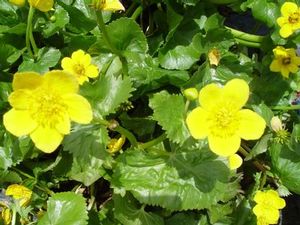Printed at http://www.newmoonnursery.com/index.cfm/
Caltha palustris
Marsh marigold
Native to North America
FIRST IMPRESSIONS: Caltha palustris is a clump forming perennial with glossy heart shaped leaves. In early spring, plants are clothed with yellow cup-shaped flowers that look as if they have been kissed by the sun. Plants thrives in sunny moist or boggy sites where the shiny golden flowers glimmer when reflected in the water.
HABITAT & HARDINESS: Caltha palustris is indigenous to mainland Europe, northern Asia and cooler northern parts of North America from Alaska to North Carolina.
This member of the Buttercup Family is at home in various types of wetlands, including swamps, wet meadows, floodplains, marshes, shorelines of ponds or creeks, seeps and ditches.
The ideal habitat is sunny and constantly wet from underground seeps or springs. Plants occur in other types of wetlands, however, as long as sun and moisture are present.
Plants are hardy from USDA Zones 3-7.
PLANT DESCRIPTION: Caltha palustris is a low mounding perennial with hollow branched stems and shiny foliage. The glossy leaves are bright green and heart shaped or kidney shaped with wavy margins.
Floral displays begin early in the season and are considered to be a welcome sign of spring. The 1” blossoms are waxy, cup shaped and similar to those of its buttercup cousins. The flowers have bright yellow sepals and no petals.
Plants grow 1’ tall with 1-2’ spread.
CULTURAL & MAINTENANCE NEEDS: Caltha palustris grows best in full sun or part sun in wet mucky soils or in shallow standing water. Plants thrive in soils with high humus levels and tolerate alkaline soils. If soils become temporarily dry, plants go dormant but will generally survive.
Due to high levels of alkaloids and glycosides in the leaves, plants are pest resistant and unpalatable to deer and rabbits. The flowers attract beneficial pollinating flies and bees. Seeds are eaten by Wood Ducks, some other gamebirds and small rodents.
After establishment, excess shade, competition from neighboring plants or drought are the only conditions that hinder growth.
LANDSCAPE USES: This is a good choice for a Water Garden, Bog Garden or Wet Meadow. Plants are also used as an Accent and as part of a Groundcover or Mass Planting. Caltha palustris has Showy Blooms and can be used in Deer Resistant Plantings and Wetlands.
COMPANION & UNDERSTUDY PLANTS: Try pairing with Acorus americanus, Chelone glabra, Iris versicolor, Lobelia siphilitica, or Osmunda cinnamomea.,
Anemone canadensis or Senecio aureus have similar height, texture and cultural needs and can be substituted if needed.
TRIVIA: Caltha palustris is thought to be an ancient species that has existed since before the last Ice Age. There is no fossil record of this plant but its wide distribution and primitive flower structures are indicators that it is a living fossil.
Young leaves were used as a spring vegetable after cooking and discarding the water two or three times. Flower buds were also cooked and pickled to use as a caper substitute. Plant parts are toxic if eaten raw but the toxins degrade when heated
The common name of marigold started out as “Mary Gold” in reference to its use in medieval churches at Easter as a tribute to the Virgin Mary.
Height:
1 ftSpread:
1-2 ftSpacing:
18-24 inUSDA Hardiness Zone:
3-7Bloom Color:
YellowCaltha palustris Characteristics
Attracts Wildlife
- Butterflies
- Pollinators
Attributes
- East-Coast Native
- Drought Tolerant
- Rain Garden
- Coastal
- Clay Soil
- Bog
- Naturalizing
Exposure
- Full Sun to Full Shade
Deer Resistant
- Deer Resistant
Flowering Months
- June
- May
- April
Foliage Color
- Green
Growth Rate
- Medium
Salt Tolerance
- High
Season of Interest (Foliage)
- Summer
- Spring
Soil Moisture Preference
- Wet to Moist
Interesting Notes:
For more information on this plant, visit the USDA PLANTS Database: http://plants.usda.gov/java/profile?symbol=CAPA5

